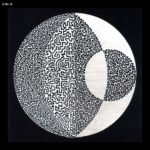


















featured gallery for April 2011
The Architecture of Loss: Mark Morrisroe, 1959-1989
I wonder how they will actually cease and come to an end as drawings, and into what new phases of being they will then enter.
-- Samuel Butler, The Way of All Flesh
Sur Rodney (Sur): Decades have passed now since Mark Morrisroe's untimely death. Until very recently his photography has been presented on occasion without any major acknowledgement of the artist's significance in relation to his influence. Seeing the immense body of work from the Morrisroe Estate's recent catalogue presently being put forward (Ringier Collection, Fotomuseum Winterthur) along with these non-photo works that were left to you by Mark, I'm beginning to recognize something that I hadn't considered before -- Morrisroe was using his photographed imagery as a canvas to paint on as well as using it as a template to make paintings and prints.
Rafael Sanchez: That is accurate both in that painting was a considerable aspect of Mark's mind-set and that there has been scant evidence of this in the way that his work has been presented up until very recently. In part this may be due to the intensity of Mark's biography that is evident as subject matter in much of his work. The main thing to keep in mind in this regard is that ultimately for Mark the chemistry and processes of photography were his painterly tools and that meaning was penultimate as techniques and explorations met with his primary subject, his life.
SRS: So that's to say that there was, in a sense, a kind of playful fusion going on. Looking back at what was happening in the New York art world of the 1980s, the decade of Mark's productive output, there was much inter-referencing and exchange between artists' production methods and mediums ... any given show at International With Monument, for example, was cause to consider this interface.
RS: And there was comedy involved, if you could sift through the rhetoric and art-speak. Mark was very aware and interested in that, the comedy. For example, there were a bunch of typed out jokes Mark came up with that he used to make a series of photograms with. One of them read, "What do cowboy hats and hemorrhoids have in common? Sooner or later every asshole gets one." That was partly directed at Richard Prince, whose Marlboro Man pieces were getting a lot of attention at the time.
SRS: The political climate of the 80s is often overlooked as well in terms of art production partially due to the big party that was going on. The term zeitgeist was often used in just about every piece of art criticism in those days. It was the Reagan era, which produced a kind of self-determination and economic boom on the one hand and a gross misappropriation of priorities on the other. The Cold War was being played out with death squads in Central America, Apartheid in South Africa and AIDS was at our doorstep in a very real way. New York City was simultaneously opulent and falling apart. Graffiti and Punk aesthetics were brought into the galleries with large bank accounts. Artist led coalitions like Group Material and ACT-UP were very effective in presenting a social criticism through a mixture of innovative media overlap. Morrisroe's work falls somewhere in between these extremes, in terms of social conscientiousness. Was any of this pertinent to his thinking?
RS: Once in New York Mark did not fit into any of this, though as Mark Dirt (his punk alias in Boston) and with DIRT magazine he had already qualified quite a punk reputation in Boston for himself at a very early age. That probably heightened his awareness of what was going on around him in New York to some extent. But one has to understand that he was not at all interested in politicizing his sexuality. He was completely open about it and it was part of him and his work as truth. Period. That was completely brave and political in itself. Even later as he was being destroyed by the disease that swallowed him whole, he chose to deal with it as an aesthete. Of course he was angry. Who wouldn't be? But it is a testament of strength that he stayed on point with his art as a playful source of creative purity. I'd also go as far as to say that art itself gave him strength in that fight. That being said, he understood that he had the power to challenge assumptions through his work and he very much enjoyed being provocative.
